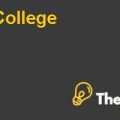
Case Summary
The Children’s Hospital of Western Ontario (CHWO) has been located in the city of the London, Ontario, Canada. The basic purpose of the hospital is to provide specialized services to the children where the hospital is a part of the London Health Sciences Center. The Children’s Hospital of Western Ontario serves a total of 10 counties where it catered the health of around 400,000 children and a total number of residents treated by the hospital was around 1.4 million people. As stated in the case, the clinic is open three times a week with half session thrice a week. The clinic in the hospital was opened three days a week from Monday to Wednesday.
The timings for the clinic were 8:30 am to 1:00 pm. During the half day shift, the clinics served 80 patients each day, out of which 60 percent of the patients were the returning patients are the ones who had to follow up with the doctors. During each day, the staff that was included was a surgeon, three clerks, two senior resident students and a total of four registered nurses. However, the remaining days of the week the clinics were used for the sub specialties of the surgery. The services of CHWO which included the Pediatric Orthopedic Clinic was managed by the division of the surgery. This clinic was used by the young patients that have faced severe bone injury or a complex bone trauma. Most of the times as stated in the case, the doctors had to treat the returning or the follow up patients. The process flow at The Children’s Hospital of Western Ontario was as follows:
The patient arrived and submitted his health insurance papers at the front desk.
The next step was that the patient waited in the reception area for an X-ray where he was briefed by the technical expert on the next step.
Then the patient had to wait for the result of X-ray
After this the patient returns to the clinic along with the X-ray where he hands it to the registration desk and waits for his turn.
At the next step, the patient is examined by the surgeon or the resident student who ever is available
Problem Statement
As the case states, the problem identified in the case is that the patients had to wait for long times for a treatment. Although the hospital had been serving the needs of children living around and near Ontario, Canada whereas it also catered the needs of United States patients also. With all this, the waiting time for the patients increased, therefore the management had decided to reduce the waiting time by at least 20 percent in the future.
Question: 01
To calculate the activity utilization rate at each of the processes can be analyzed from the data provided regarding the patient surveys and the time information. To calculate the utilization rates each division has been calculated individually with specific job title for each utilization rate. To find the utilization rates of being all the individual job functions, the total number of hours that are being spent on the process will therefore will be divided by the total number of hours that will be available for the work for each separate worker. Therefore, to calculate the utilization rates for the clerks as calculated in Appendix – 1 is 74.07%. For the three main nurses the utilization rate as calculated in Appendix – 1 is 81.83 %, the utilization of the technicians is 83.42 %. The utilization rate for the radiologist is 75.83 %. For the extra nurses is 57.25 %, the rate of utilization for the surgeon is 110.43 %, for the senior resident this rate is 92.24% and for the technical it is 90.04% as calculated in Appendix – 1. And to calculate the utilization for the each individual division, the calculation will be based on the number of total hours that are spent in the division, which will be divided by the total number of hours for the particular division. With this the corresponding division for the utilization rates will be therefore 67.43 % for the front desk, 28.63 % for the X-ray, for the radiology the utilization rates as calculated in Appendix – B will be 69.83 % and the utilization rate for the examination room will be 97.57% as per the calculation in Appendix – B.
Question: 02
The pediatric department, Chest clinic, Urology and ER are using radiology department. Therefore, itis proposed varied demands which depend on the patient arrives for all the departments mentioned that cause the variability in the amount of time a patient has to wait for a treatment. With only one radiology department and since the patients are quite a lot therefore it takes extra time for all patients to wait................
This is just a sample partial case solution. Please place the order on the website to order your own originally done case solution.













